
There’s much talk about digital twins, but what’s it like to actually design and build one? Denise Chevin talked to Anthony Day, managing director of IMA Architects, to find out.
When Anthony Day wanted to turn two former shipping containers outside the office into a coffee bar and a gym for staff, he decided the new facilities would have another purpose: the project could serve as a test bed for a digital twin.
The technology, which creates a digital replica of a physical building complete with sensors to monitor changes in fabric, helps companies gain more data about a building’s performance in real-time, potentially helping them to save money.
Leicestershire-based IMA Architects, set up 25 years ago, has been at the forefront of digital technology. It was an early adopter of Autodesk Revit and has recently achieved ISO 19650, information management and BIM certification.
Inspired by the National Digital Twin Programme (to create an interconnected network of infrastructure) and seeing the potential benefits for many of its clients, IMA began working on digital twin development in autumn 2022. Fortuitously, a member of staff, Dr Asem Al Bunni, had just completed a PhD in BIM and digital twins, which helped considerably.

“I’ve found that there’s quite a big misunderstanding in the market of what a digital twin is. I think a lot of people think it’s an as-built Revit model. And really, it’s a lot more than that.”
As IMA learns from the experience, Day hopes to be able to offer a service to clients, some of which are logistics businesses with huge warehouse developments in the M1 corridor. The firm also designs residential and other commercial developments.
Day explains the challenges and benefits of the system.
BIMplus: How did you set up the digital twin?
Anthony Day: We fully designed and modelled the fit-out of the containers in Revit, which meant putting in insulation, plaster boarding and a removable ceiling that allows access to sensors. Both containers have a great number of sensors built into them, including:
- environmental sensors (temperature, humidity, air quality, fire system, rain);
- light monitoring sensors;
- power monitoring sensors (individual devices/spotlights feedback);
- motion detection sensors;
- GPS sensors that locate devices relative to project location and display on a map)
- USB outlets monitoring sensors;
- door closure and window monitoring sensors and
- the ability to expand with further IoT sensors.
All the monitors are then linked back to the digital twin interface, where a 3D digital representation of the physical asset is visible. The data collected by the sensors is analysed within a cloud platform and visualised via the digital model. The data can also be stored in the cloud for further analysis and used for research and development. Commands can also be sent from the digital model to activate or deactivate devices in the pods.
Having a GPS coordinate sensor means that if you have a mobile piece of equipment, you can geotag it and know if it’s been removed. Or, if something happens within the building out of hours or when people are off site, this will be visible on the digital twin, meaning that changes can then be made in the physical building via the user interface on the digital twin.
There’s no limit to the sensors that can be used. It’s very flexible. Similarly, the user interface is completely customisable, which means that you don’t need to be an expert to be able to operate it or retrieve data. IMA has an architect in Turkey who’s an expert in coding, and he has been helping on the project.
What’s the difference between digital twinning and a building management system (BMS)?
The main difference is that the BMS is a series of sensors that are linked back into a computer. But in terms of data capture and data analysis, the user interface is simplistic. In a digital twin, sensors are read in real-time and, because of the way they link back through a cloud-based system, the digital twin can be accessed through pixel streaming on any laptop with the correct login details.
I’ve found that there’s quite a big misunderstanding in the market of what a digital twin is. I think a lot of people think it’s an as-built Revit model. And really, it’s a lot more than that. So there’s perhaps a bit of education needed, even within our own sector.

What have been the main challenges getting the system to work?
The wiring requirements for the sensors meant it was difficult to find electrical contractors who had the skills to undertake the installation. The wiring needed to be double-cabled to control the switching of the lights and the switch socket outlet.
The system now has the functionality that we want, but we will continue to tweak. One of the things we’re looking to explore is using off-the-shelf BMS systems that already have sensors built in to try to reduce the amount of cabling required and simplify installation.
How do you think your clients will benefit from digital twins?
“The monitoring of energy use will be one of the biggest benefits from establishing a digital twin, both in terms of cost savings, but also to ensure that buildings are compliant with the energy standards.”
In all kinds of ways. A digital twin can monitor and process a huge amount of information in a building. If we take the example of a university, monitoring the footfall in rooms provides the opportunity for redeployment of spaces where the university might otherwise be looking at, say, an extension or other physical alteration, when in fact that’s not required.
For a large warehouse logistics system, which we frequently work on, a building manager could see in real-time if there was a particular room that was losing a lot of heat. It could be something as simple as someone leaving a window open, or be highlighting an issue with the insulation in the building that would need to be professionally repaired.
We believe the monitoring of energy use will be one of the biggest benefits from establishing a digital twin, both in terms of cost savings, but also to ensure that buildings are compliant with the Minimum Energy Efficiency Standards (MEES) that are coming into effect for commercial buildings.
Another use would be to embed sensors to monitor structures. Generally in logistics centres, there tends to be a lot of impact protection, because sometimes forklift operatives drive into bits of steelwork. Sensors can be embedded into the impact protection material to assess the severity of any impact on supporting structures.
Similarly, with the distribution centres, the geolocation tagging of the manual pallet trucks would be useful because HGV drivers can drive off with them [still in their truck] by mistake.
We are talking to our longstanding clients about the technology, but for the moment, we just want to make sure that it works well for us.
Do you think digital twins will take off?
It might be that the development of a digital twin is driven through the ISO 19650 process, because clients can see that it will yield a benefit to them. We also think it will be driven by the impact it can have on reducing energy consumption. Businesses will see value in technology that can help them save money and help the environment, as well as improving overall building management. The MEES introduction is likely to fuel this in 2023 and beyond.
People won’t use something if it doesn’t make that much of a difference and it’s too hard to use, which is why digital twins need to be impactful and easier to use. What is going to matter to building owners and developers is being able to provide savings in terms of time, money and energy.
Don’t miss out on BIM and digital construction news: sign up to receive the BIMplus newsletter.












